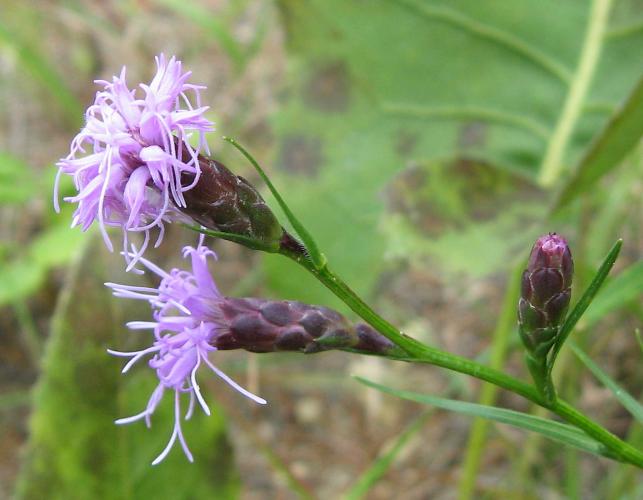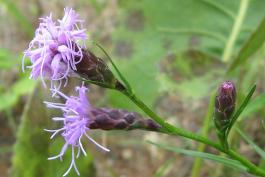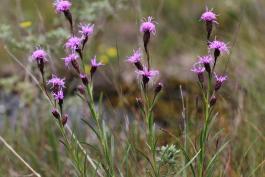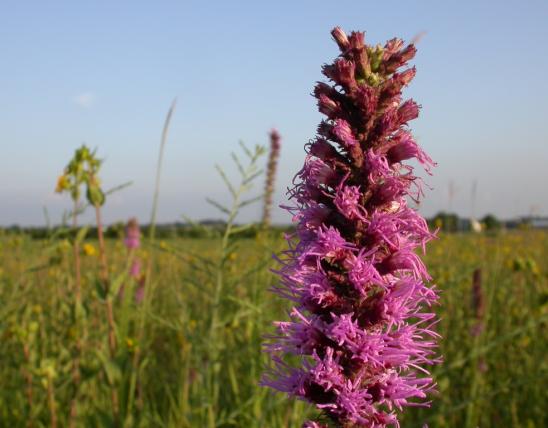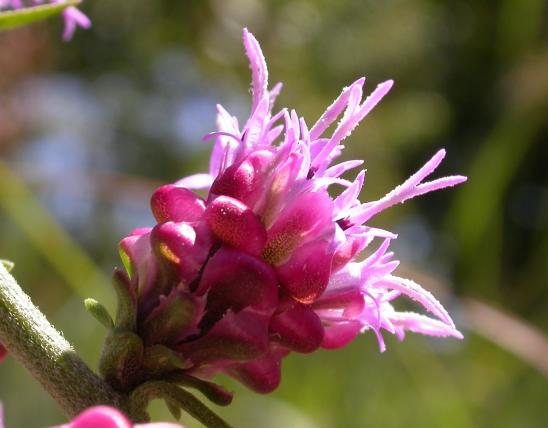
Cylindrical blazing star is one of several native Missouri species of blazing stars, or gayfeathers. It is widely scattered in the Ozarks and in eastern Missouri. Identify it by its bracts, which are pressed against the base of the flowerhead, accentuating its cylindrical look.
Missouri boasts nine native species of blazing stars (genus Liatris). These showy, upright, unbranching spikes of magenta-pink wildflowers typically bloom in sunny habitats. Like other blazing stars, cylindrical blazing star is a perennial with composite flowers: the actual flowers (florets) are tiny and grouped into flowerheads. Unlike more famous members of the sunflower family, blazing stars have no petal-like ray florets. Because they have only disc florets, the flowerheads look fuzzy. Liatris flowers are usually pink to reddish purple or magenta; the styles (elongated tops of the pistils) are 2-branched, threadlike, and protrude far outside the 5-lobed petal tube.
Cylindrical blazing star is an overall smooth, usually hairless plant, with the rootstock a globe-shaped corm. For a blazing star, it is very short (no more than a foot tall) and has notably stiff stems.
In cylindrical blazing star, the basal and stem leaves, and most others, have 3 or 5 main veins; the basal leaves are the largest and reach about 10 inches long and less than ¼ inch wide; the leaves become smaller and narrower (grasslike) up the stem; stalkless, smooth, and usually shiny.
The flowerheads are alternate, usually on short, stiff stems to 1½ inches long (sometimes they are stemless, but rarely the stems can be up to 2½ inches), spaced far enough apart so that you can easily see the stalk between them. Each flowerhead holds 10–35 florets. The florets are usually pinkish or reddish purple, but rarely they can be white. The involucre (at the base of each flowerhead) is narrowly cup-shaped or vase-shaped to nearly cylindrical. The involucral bracts are rounded, triangular, to oval with rounded or short, sharp tips. They are smooth, hairless, flat, and appressed (not spreading or curling away), which accentuates the cylindrical look of the involucre. Blooms July–September.
Learn more about this and Missouri’s other blazing stars on their group page.
Similar species: Compared to Missouri’s other species of blazing stars, cylindrical blazing star is most similar to scaly blazing star (L. squarrosa). Both are short (for blazing stars) and have the flowerheads alternate on the stalk (not crowded together). Both have 3 or 5 main veins in the leaves. But note these differences:
- In L. squarrosa, the involucral bracts curl away from the involucre, making the involucres look something like burs. In L. cylindracea, the bracts are appressed, accentuating the cylindrical look of the flowerhead base.
- L. squarrosa is often a hairy plant, while L. cylindracea is usually smooth.
- The topmost flowerhead in L. squarrosa is usually noticeably bigger, containing more florets, while the flowerheads of L. cylindracea are usually about the same size.
- L. cylindracea does not grow taller than 12 inches, while L. squarrosa may grow up to 30 inches in height.
Where they grow near one another, L. squarrosa and L. cylindracea sometimes hybridize, and their offspring may look like a confusing blend of both. Indeed, all of Missouri’s different Liatris species may interbreed and create hybrids, where they grow near enough for cross-pollination to occur among the plants. Also, the hybrid offspring plants are often fertile and can make a colony. If you find a blazing star (or patch of blazing stars) that seems to be intermediate between official species descriptions, you may have found a hybrid. Look around for one or two of the possible parent species growing nearby.
Height: usually 8–12 inches, very short; our shortest blazing star.
Scattered in the Ozark and Ozark border regions and north on the eastern half of the state.
Habitat and Conservation
Cylindrical blazing star occurs in glades, ledges and tops of bluffs, openings of dry upland forests, and upland prairies; also pastures and roadsides.
Status
Native perennial wildflower.
Human Connections
Named cylindracea for the elongated, fairly cylindrical involucre at the base of each flowerhead.
Blazing stars are among the showier plants to grace native wildflower gardens as well as formal landscape plantings. Several species are in cultivation — especially the tall ones with long, densely packed floral spikes. This species, with its relatively dainty growth and attractive flowerheads, deserves to be cultivated more often.
In gardens, blazing stars are popular because they are a magnet for pollinators such as butterflies and bees. Birds feed on the seeds. The sweet, thickened rootstocks, however, are attractive to voles and other herbivorous mammals.
Ecosystem Connections
Many types of insects visit blazing stars for food. A wide variety of butterflies and skippers, bees, beetles, flies, and others collect pollen or nectar. Aphids and other sap-suckers drink the plant juices with their strawlike bills. Moth caterpillars and many other insects chew on or bore into the leaves, flowers, stems, rootstocks, or other plant parts.
In addition to the many insects that feed on the plants, other animals are attracted to blazing stars in order to hunt the herbivores (and each other): lady bugs, robber flies, mantises, assassin bugs, crab spiders, and more. Birds come to eat nearly any of the insects and spiders they can find.
Birds eat the fruits of blazing stars, which are like tiny sunflower seeds. Goldfinches are notable consumers of blazing stars, coneflowers, thistles, sunflowers, and sunflower-family seeds that develop in late summer as they nest late in the season. The fuzzy tufts of blazing star seeds are also used to line nests.
Mammals that eat blazing stars include rabbits, woodchuck, and deer, which graze on the aboveground parts of the plant, and voles, which gnaw on the corms or other thickened rootstocks.
